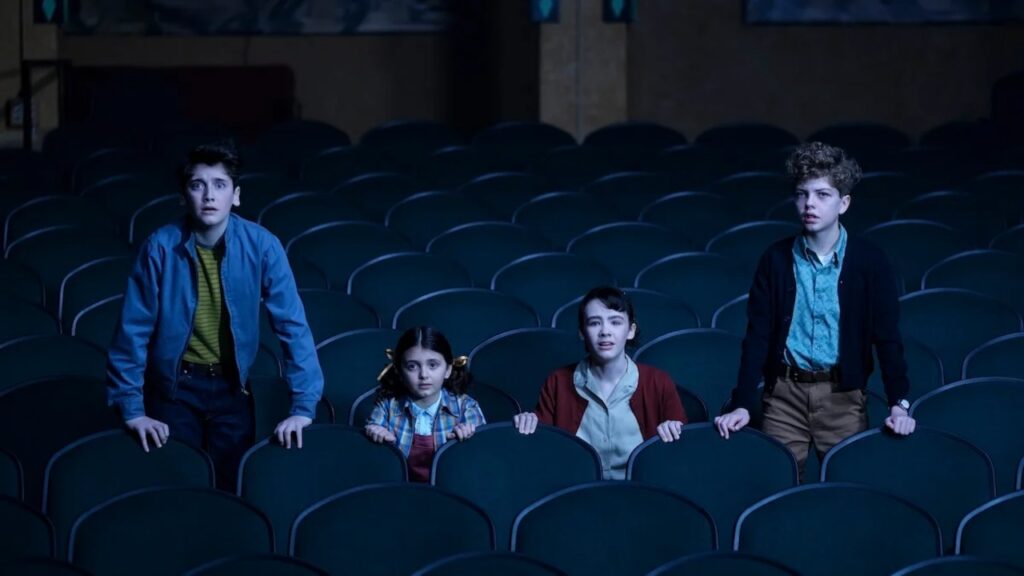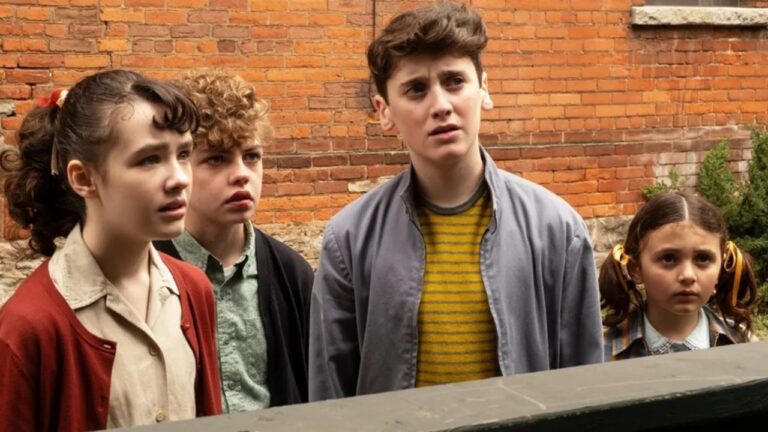Stephen King’s It has always stood as a massive story about childhood, fear, and the scars that time cannot erase. First published in 1986, the novel brought us the cursed town of Derry, Maine, where seven children known as the Losers’ Club faced an evil entity called Pennywise the Dancing Clown. Over the years, there have been multiple adaptations, from the 1990 miniseries to Andy Muschietti’s two-part film adaptation, ‘It’ (2017) and ‘It: Chapter Two‘ (2019). Each one managed to capture some of the book’s heart, though none could truly contain all of King’s sprawling world. Now, HBO’s ‘It: Welcome to Derry‘ brings us back to the nightmare with a prequel that both honors and expands what came before.
The series, created by Muschietti along with Jason Fuchs and Brad Caleb Kane, takes us to 1962, decades before the Losers’ Club made their blood oath. This time, we see the town of Derry through a different lens. The story is set in an era marked by social change, growing anxieties, and the shadow of global conflict. By focusing on this specific period, Welcome to Derry connects King’s supernatural horror with real-world fears that shaped American life. The series draws loosely from Mike Hanlon’s historical research, which in the original novel was told through interludes that explored Derry’s mysterious history.
Derry as a Character: Exploring the Town, Its People, and the Shadows Within

Unlike the earlier films, the HBO show spends time developing the town itself and the people who live in it. We meet families who have felt Derry’s troubles for generations, and we begin to see how Pennywise’s presence feeds on unkindness, prejudice, and neglect. The show’s choice to center people of color and Indigenous voices, especially characters like Charlotte and Leroy Hanlon, played by Taylour Paige and Jovan Adepo, and Rose, portrayed by Kimberly Norris Guerrero, feels long overdue. It does not rewrite King’s story so much as complete it. For the first time, we see that the terror of Derry is not just supernatural; it is built into its streets, its history, and its silence.
Bill Skarsgård returns as Pennywise, and his performance is even more unnerving than before. Here, the clown feels less like a distant nightmare and more like an inevitable truth of Derry itself. The show never tries to explain him too much, and that choice works in its favor. Pennywise remains a mystery, a shapeshifting reflection of the town’s worst instincts. The hallucination scenes in this series go further than anything in Muschietti’s films, grim, unsettling, and grounded in absolute fear. The danger feels more intense because it is dramatic, and we understand what it represents.
Welcome to Derry, which does not rely on constant jump scares or CGI spectacle. Instead, it builds tension through quiet dread, showing how everyday meanness and unfairness make space for something like Pennywise to thrive. Even when adults cannot see him, their unkind choices seem to invite him in. There is a haunting sense that Derry’s troubles have no true beginning or end, and that the monster will always return as long as people ignore what is wrong around them.
Another standout element is the ensemble cast. Chris Chalk as Hallorann, the psychic cook from The Shining, brings a thoughtful connection to the larger Stephen King universe. The series includes references that fans will enjoy, like a Shawshank Prison bus or subtle nods to Maturin, the cosmic turtle god who balances Pennywise’s evil. But these touches are never forced. They add texture rather than distraction, making the story feel like part of a much bigger world without taking away from its focus on Derry itself.
The Endless Echo of Pennywise Lies Beneath the Streets of Derry

Muschietti and his team seem to have learned from both the successes and the shortcomings of their film adaptations. The pacing here allows each subplot and character to breathe, and the visual design restores the eerie small-town atmosphere King described in his book. The streets, the drains, the old houses all look ordinary at first glance, yet they hide something that feels deeply wrong.
While the series does not aim to replace the legacy of the Losers’ Club, it enriches our understanding of what they were fighting against. We see the origins of the town’s patterns of cruelty, and we get hints of how the next generation will have to face the same threat decades later. It is a story of cycles, fear returning repeatedly, taking new shapes but never entirely disappearing.
Of course, this first season only scratches the surface of Derry’s long and haunted history. There are plans for more seasons, and that open structure suits the story well. After all, King’s It was never about a single battle, but about how memory and trauma linger, how fear can be passed down like a shadow. Welcome to Derry gives us a new way to explore that cycle.
The show is set to release on October 26, making us wonder what else lies beneath Derry’s quiet streets. Maybe we will never know the whole truth about Pennywise, and perhaps we are not meant to. The mystery keeps us coming back, because in Derry, nothing ever really stays hidden.




